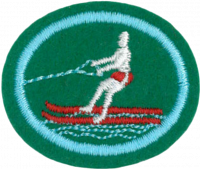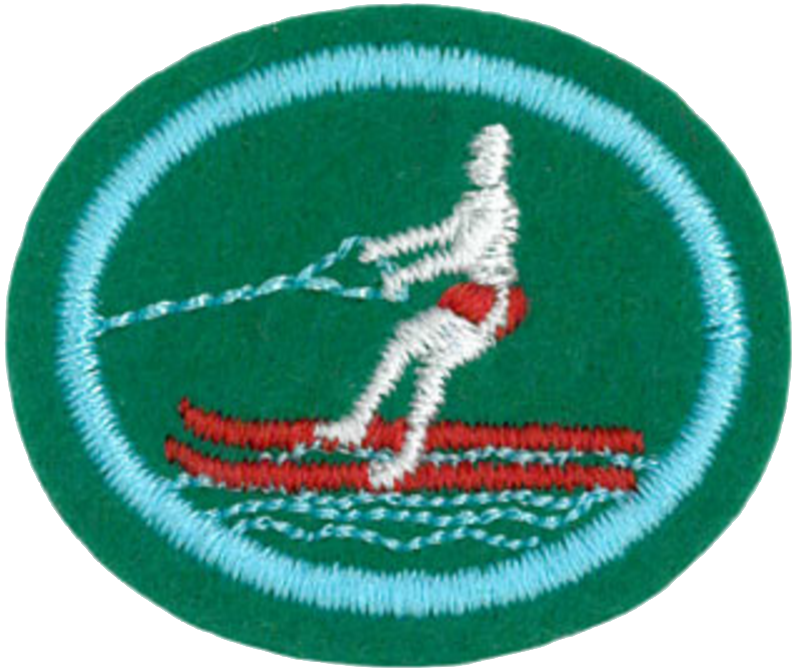Distinctions JA/Ski nautique/Réponses
1
Pour obtenir des conseils et des instructions, consultez Natation II.
2
2a
At night it is difficult for the boat driver to see hazards in the water, including the skier. The fact that the boat must travel at a high speed for skiing makes these hazards even more dangerous. They may not be seen in time to avoid them. High-speed boating accidents can be (and have been) fatal.
2b
When lightning strikes a body of water, the electricity travels across the surface&, which is exactly where a skier would be located. If you see lighting while skiing, get out of the water as soon as possible.
2c
A ski vest protects the torso from impacts. This is important when travelling across the surface of the water at a high speed. Accidents do happen, and a ski vest can save your life.
2d
A ski vest that comes off during an accident is potentially useless. Better to keep the vest on.
2e
A frayed rope can break when stressed.
2f
Bindings in poor condition can break while in use, compromising the skiers control of the skis.
2g
The driver must be made aware if the skier is in trouble. Driving a boat at high speed while oblivious to the skier being towed is a recipe for disaster.
2h
These objects can kill.
2i
Hanging on to the rope after a fall will subject the body to numerous impacts with the surface of the water. Being dragged along can also wrest the ski vest out of position.
2j
This is to let the people on the boat know you are OK. This should be your regular practice so that in the event of an injury, failure to signal will bring swift help.
2k
The likelihood of falling out of a boat is greatly increased for persons not seated. A fast boat can easily suck a person under where he can be hit by the propeller.
3
Hand signals and different people's understanding of hand signals varies, so always go through the hand signals with the boat captain, all spotters and all skiers before anyone goes in the water.
These are signals approved by the American Water Ski Association and are recommended for use on California waters. See link: http://www.dbw.ca.gov/Pubs/Watski/INDEX.HTM
3a
Thump down, motion down with hand or palm-down motion.
3b
Make the ok sign (thumb and finger to form a circle, with three other fingers up.
3c
Thumb up, motion up with hand or palm-up motion.
3d
Point down with one finger, and circle your finger. "Back around" to drop off area. Alternatively, pat crown of head with open palm meaning "return".
3e
Use hand to "cut" across your neck. As in "cut the motor"
3f
Use right or left arm to motion in the direction you want to go.
Other useful signals not in requirements
Start: Shout 'hit it' or nod head.
Jump: Raise hand up sharply, imitating a jumping arc.
Pick Me Up or Watch for Fallen Skier in Water: Hold a ski vertical in the water beside you.
4
Practice, practice, practice. You should really have an instructor for this honor.
5
This means cross the wakes without falling in the water. A good demonstration of the results of your practice.
6
6a
The standard type of skis most people start with. Two skis, one for each foot, with bindings to hold your feet. The skis may be interchangeable to make them easy to put on in deep water. Sometimes on ski has a second binding so a skier can drop the other ski and continue with just one ski.
6b
In an attempt to become as agile as possible, slalom water-skiers use only one ski with feet oriented forward, one in front of the other. Slalom skis are narrow and long, at 57–70 inches (145–178 cm) depending on the height and weight of the skier. The two forward-facing bindings vary: they can be made of rubber or thick plastic, and they can be designed more like a snow ski binding or more like a roller blade boot.
6c
Trick skiing uses small, oval-shaped waterskies. Beginners use two skis until ready to switch to one ski. The shorter, wider trick ski has a front binding facing forward and a back binding facing at a 45°. It has a smooth bottom that allows it to turn over the surface of the water. According to official 2013 Tournament Rules for 3-event competition in the United States and the Pan-Am Games, skis used in the Tricks event must be a single ski without fins, although molded rails/grooves less than 1/4" are allowed, as are a foot pad cemented to the ski as a place for the rear foot; in addition, the ski must float with all bindings, fins, etc., installed. The trick ski's configuration allows performance of both surface and air tricks in quick succession with enough practice and training.
6d
A kneeboard is a buoyant convex board similar to a surf board on which the kneeboarder kneels. A boat is used to tow while the boarder hangs on to the towrope. Some kneeboards have fins and some do not for increased maneuverability. Most use Velcro straps to secure the knees.
References
- Hand Signals and Safety (California) http://www.dbw.ca.gov/Pubs/Watski/INDEX.HTM
- http://en.m.wikipedia.org/wiki/Waterskiing


